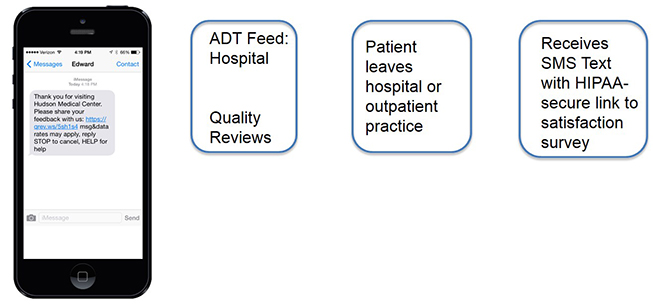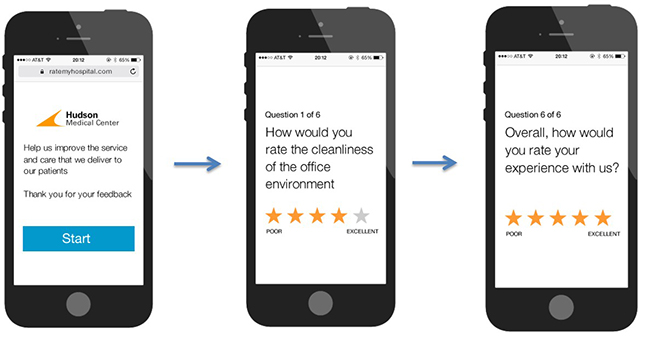Patients/Consumers: Relationships Matter
Patients/Consumers: Relationships Matter
By Barry P. Chaiken, MD, MPH; and Edward Shin, MD
Yelp. TripAdvisor. Angie’s List. Healthgrades. No individual or organization maintains immunity from scrutiny by their customers. Reviews can be uplifting and embarrassing, and they surely capture the attention of both the reviewer and the reviewed.
As the Affordable Care Act expands coverage and high-deductible health plans capture more money from consumer pockets, increasing numbers of patients focus on the quality of services received from providers. These services extend beyond patient care to encompass patient experience metrics that are easily judged by the average consumer: respectfulness exhibited by caregivers, pleasantness of facilities, and wait times. Patients with sub-par experiences often post negative comments on one or more social media platforms to express their dissatisfaction. These posts form the building blocks for a provider’s online reputation.
As patients act more like consumers, provider organizations with poor reputations experience decreased utilization of services, which hurts revenue and the bottom line. With margins small and competition increasing for patients, few organizations can afford a decline in patient visits. To survive in this new era of healthcare consumerism, providers must learn from the experiences of other industries, such as retail and hospitality, and apply those basic approaches to managing their relationships with patients/consumers.
Why Relationships Matter
For more than 60 years, employer-based insurance dominated the payment structure for the delivery of healthcare. With employees shielded from the actual costs of care, demand for services rose faster than inflation, causing the cost of care to rise in lock step. Only when healthcare costs started to impact the competitiveness of American businesses did employers begin to shift the cost burden of care to employees. Additionally, with pressure imposed by these same employers, insurers became more concerned about costs and began to resist price increases from provider organizations. Healthcare costs became the concern of all sectors of the healthcare marketplace, including patients who now were responsible for an increasingly painful portion of their healthcare costs.
The shifting cost burden is not the only factor driving the importance of patient relationships. The disruption caused by the Affordable Care Act brought millions of additional patients/consumers into the marketplace. Provider organizations work to attract as many existing and new patients/consumers as possible to fill facilities and generate revenue. Providers now base their survival on making their connection to these patients/consumers “sticky” the same way consumers exhibit loyalty to a particular restaurant, hair salon, or grocery store.
The Old Way
Established efforts to measure patient satisfaction—notice this is not called patient/consumer satisfaction—include the HCAHPS (Hospital Consumer Assessment of Healthcare Providers and Systems) survey and similar efforts provided by organizations such as Press Ganey. According to the Centers for Medicare and Medicaid Services:
The HCAHPS survey asks discharged patients 27 questions about their recent hospital stay. The survey contains 18 core questions about critical aspects of patients’ hospital experiences (communication with nurses and doctors, the responsiveness of hospital staff, the cleanliness and quietness of the hospital environment, pain management, communication about medicines, discharge information, overall rating of hospital, and would they recommend the hospital). The survey also includes four items to direct patients to relevant questions, three items to adjust for the mix of patients across hospitals, and two items that support Congressionally-mandated reports.
The HCAHPS survey is administered to a random sample of adult patients across medical conditions between 48 hours and six weeks after discharge.
Other survey instruments use similar approaches: paper, phone, and email. Imagine if Yelp required consumers to complete a 27-question questionnaire that was mailed or emailed.
Begun just 10 years ago, Yelp has recorded more than 67 million reviews, receives 139 million visitors per month, and currently obtains more than 35% of its reviews from mobile phones (Smith, 2015). In this age of social media and smartphones, can provider organizations safely ignore the trends of consumerism and continue to embrace paper, phone, and email to build their patient-consumer relationships?
Welcome to PRM
Patient Relationship Management (PRM) represents healthcare’s version of customer relationship management (CRM). CRM facilitates the interaction with current and future customers by leveraging information technology. It helps organize, automate, and coordinate sales activities, and supports marketing customer service and technical support efforts.
In addition, CRM often uses social media to build customer relationships. For example, many organizations employ Twitter, Facebook, and LinkedIn as CRM tools to track and communicate with customers, and permit them to share their opinions and experiences with companies, products, and services.
As CRM is relatively new to healthcare providers, organizations must be careful how they design their PRM programs. In addition, they must identify clear goals and objectives for their programs and understand the options available to them for responding to patient feedback.
Healthcare’s reliance on PRM programs that employ HCAHPS-type initiatives—paper questionnaires, phone interviews, or email—fails to take advantage of other means of interacting with patients. In addition, traditional approaches to reaching patients deliver low response levels and suffer from inaccuracy due to the delay between patient interaction and administration of a survey.
In contrast, smartphones offer a powerful tool for interacting with patients in a meaningful and timely manner. Using smartphone texting and Internet access capabilities allows organizations to effectively reach patients to gather their responses. Used by 90% of adults in the U.S., cellphones are truly a ubiquitous information technology device (Pew Research).
Linking a care delivery episode to a patient’s perception of delivered services offers a view of how successfully an organization is satisfying the needs of patients. If the goal of a provider organization is to attract and retain patients, obtaining this PRM information allows organizations to continually monitor patient perceptions of care delivery and make adjustments as needed.
Figure 1 shows how smartphones can be used to obtain a quick, online survey from a patient who had recently received care. Using the hospital’s admission-discharge-transfer (ADT) system to identify those who have just received treatment, software can send the patient a text message that includes a secure link to a short online survey.

Figure 1
Figure 2 presents an example of what a linked survey might look like. To maximize the response rate, surveys are kept short—less than 10 questions—and responses are on a simple one-to-five-star scale.

Figure 2
Using this technology to reach patients in an oncology practice delivered a response rate 5.6 times greater than patient surveys used previously at the facility. In addition, the median response time was 54 minutes versus one month for traditional surveys. Survey costs equaled just 6% of the cost of traditional methods.
Analysis of collected PRM data provides valuable information about which initiatives might provide enhanced relationships with patients/consumers. Dashboards generated from the data guide managers on the status of operations and potential problem areas.
Solidifying Relationships
As provider organizations adjust to an era where attracting and retaining patients matters, solidifying those relationships requires a strong feedback loop that links care delivered with patient-perceived value. Paper questionnaires and other traditional survey methods fail to account for the importance of linking care and response in a timely manner. Patient-consumers, trained by other industry CRM efforts to expect close relationships with products and service vendors, are beginning to expect similar experiences with their various healthcare providers. In addition, as more of these patients/consumers pay for their own care, they increasingly scrutinize the care experience they purchase.
To track their own performance and adjust nimbly to patient perceptions and needs, organizations require technology tools to secure actionable, timely information from patient-consumers. Smartphones, and their delivery of applications similar to those shown above, offer provider organizations a valuable tool to support their efforts to maintain strong and binding patient/consumer relationships.
Barry Chaiken is the chief medical information officer of Infor. With more than 20 years of experience in medical research, epidemiology, clinical information technology, and patient safety, Chaiken is board certified in general preventive medicine and public health and is a Fellow and former Board member and Chair of HIMSS. As founder of DocsNetwork, Ltd., he worked on quality improvement studies, health IT clinical transformation projects, and clinical investigations for the National Institutes of Health, UK National Health Service, and Boston University Medical School. He is currently an adjunct professor of informatics at Boston University’s School of Management. Chaiken may be contacted at barry.chaiken@infor.com.
Edward Shin is CEO and co-founder of Quality Reviews, Inc., developer of a real-time patient feedback tool for hospitals, RateMyHospital®. Board-certified in internal medicine, Shin has over 15 years of experience as a serial entrepreneur, having founded two health IT start-up companies, Healogica and WellApps. Shin also led the healthcare team at Gerson Lehrman Group, the leading expert network company. Shin can be reached at ed@q-reviews.com.
References
Centers for Medicare & Medicaid Services. (n.d.). HCAHPS: Patients’ perspectives of care survey. Survey. Retrieved January 23, 2015, from http://www.cms.gov/Medicare/Quality-Initiatives-Patient-Assessment-Instruments/HospitalQualityInits/HospitalHCAHPS.html
Customer relationship management. (2015, January 23). In Wikipedia, The Free Encyclopedia. Retrieved 03:26, January 24, 2015, from http://en.wikipedia.org/w/index.php?title=Customer_relationship_management&oldid=643877538
Digital Marketing Ramblings. Retrieved January 23, 2015, from http://expandedramblings.com/index.php/yelp-statistics/
Pew Research Internet Project. (n.d.). Mobile technology fact sheet. Retrieved January 25, 2015, from http://www.pewinternet.org/fact-sheets/mobile-technology-fact-sheet/
Smith, C. (2015, January 2). By the numbers: 40 amazing Yelp statistics. Digital Marketing Ramblings… Retrieved from http://expandedramblings.com/index.php/yelp-statistics/
